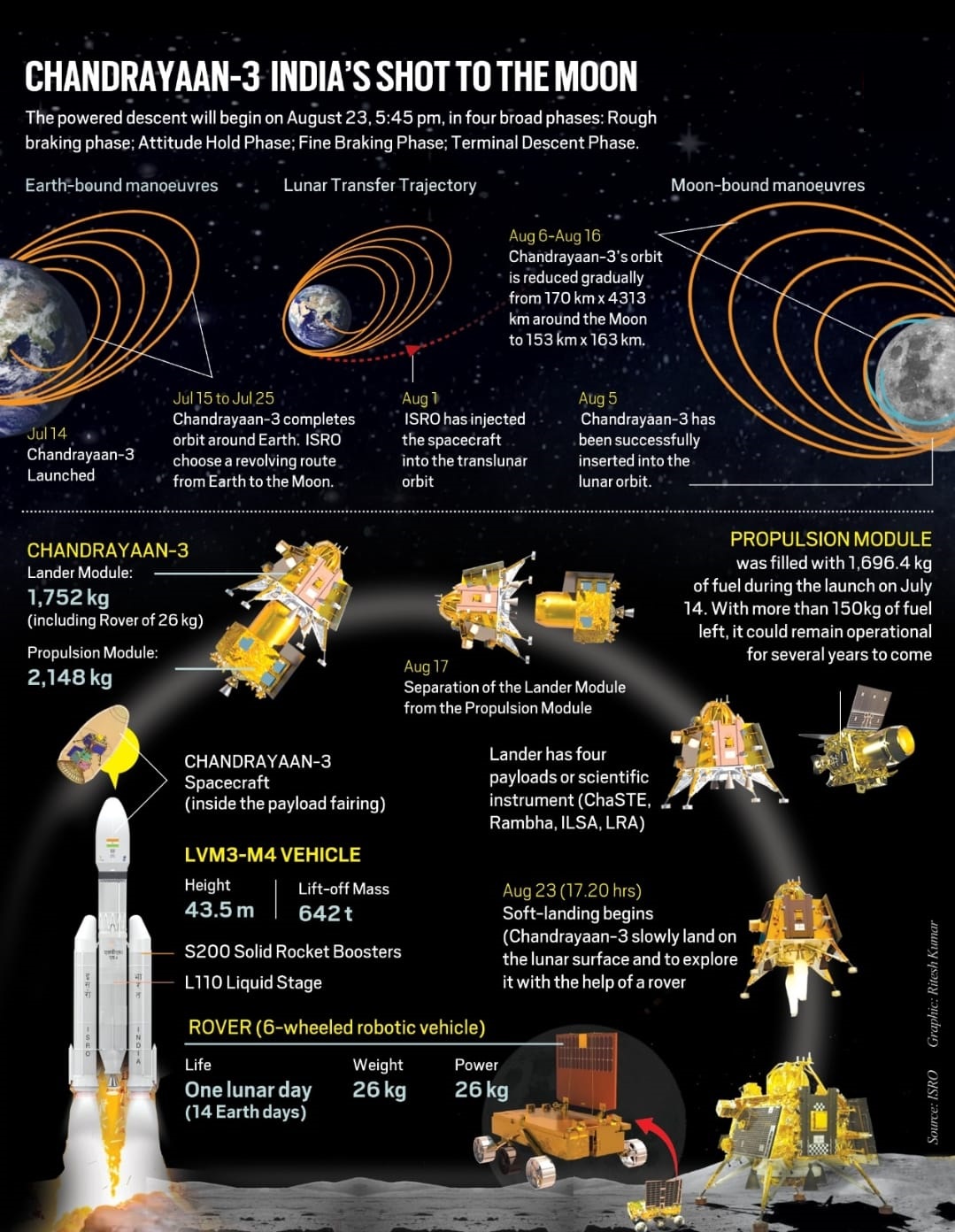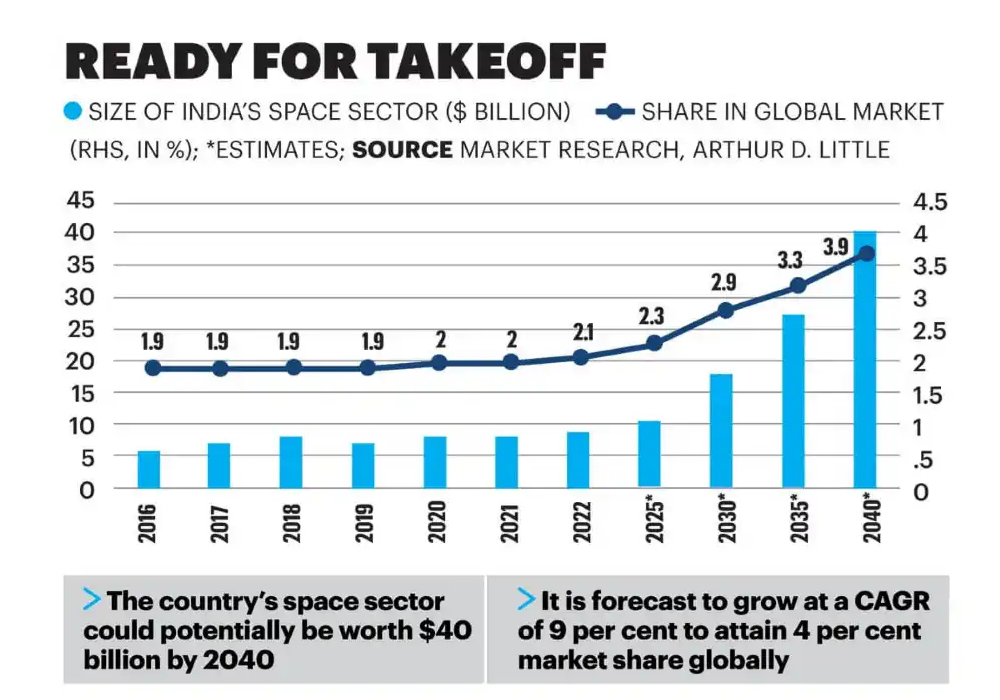Science & Technology
Chandrayaan-3 : India's Imperatives for Space Leadership
- 13 Nov 2023
- 15 min read
This editorial is based on 5 key takeaways for New Delhi | After the celebration: How Moonshot clears the way for the big & the bold which was published in The Indian Express on 11/11/2023. It talks about the significance of Chandrayaan-3 mission to explore the lunar south pole, marking a pivotal moment in India's space exploration initiatives.
For Prelims:Chandrayaan-3, Spectro-polarimetry of Habitable Planet Earth (SHAPE), Chandra’s Surface Thermophysical Experiment (ChaSTE), Chandrayaan-4, XPoSat (X-ray Polarimeter Satellite), NISAR, Gaganyaan, Shukrayaan 1, InSPACe (Indian National Space Promotion and Authorisation Centre.
For Mains: About Chandrayaan-3, Significance of Chandrayaan-3 Programme, Future Space Programme of ISRO, Key Challenges in the Indian Space Programme Mission.
Chandrayaan-3's exploration of the lunar south pole signifies a new era in India's space endeavors.India's successful soft landing near the Moon's south pole is a moment of national pride, establishing the country as the first to achieve this remarkable feat of landing a spacecraft in such proximity to the lunar south pole. This achievement presents an opportunity for India to lead in transforming the relationship between humanity and outer space.
What is the Chandrayaan-3 Programme?
- About :
- Chandrayaan-3 is India's third lunar mission and second attempt at achieving a soft landing on the moon's surface.
- On July 14, 2023, Chandrayaan-3 took off from the Satish Dhawan Space Centre in Sriharikota. The spacecraft seamlessly entered lunar orbit on August 5, 2023. The historic moment unfolded when the lander made a successful touchdown near the Lunar south pole on Aug 23, 2023.
- Mission Objectives :
- To demonstrate Safe and Soft Landing on Lunar Surface
- To demonstrate Rover roving on the moon and
- To conduct in-situ scientific experiments.
- Components:
- Chandrayaan-3 is a three-component mission consisting of a Propulsion Module, a Lander Module, and a Rover Module.
- The Propulsion Module : It will carry the lander and rover configuration till 100 km lunar orbit.This propulsion module has Spectro-polarimetry of Habitable Planet Earth (SHAPE) payload to study the spectral and Polari metric measurements of Earth from the lunar orbit.
- The Lander Module: The Lander Module (Vikram) is carrying a scientific payload that includes a suite of instruments to study the lunar surface and atmosphere Chandra’s Surface Thermophysical Experiment (ChaSTE) to measure the thermal conductivity and temperature; Instrument for Lunar Seismic Activity (ILSA) for measuring the seismicity around the landing site; Langmuir Probe (LP) to estimate the plasma density and its variations. A passive Laser Retroreflector Array from NASA is accommodated for lunar laser ranging studies.
- The Rover Module:The Rover Module(Pragyan) is carrying a suite of instruments to study the lunar surface and subsurface which includes Alpha Particle X-ray Spectrometer (APXS) and Laser Induced Breakdown Spectroscopy (LIBS) for deriving the elemental composition in the vicinity of landing site.
- Major Findings :
- Lunar Surface Temperature Surprise:Chandra's Surface Thermophysical Experiment (ChaSTE) measured temperatures reaching 70 degrees Celsius, surprising scientists who expected temperatures between 20 to 30 degrees Celsius.
- Lunar Surface Elements Confirmed:The Laser-Induced Breakdown Spectroscopy instrument onboard 'Pragyan' rover confirmed the presence of Sulphur on the lunar surface near the south pole.Elements such as Aluminum, Calcium, Iron, Chromium, Titanium, Manganese, Silicon, and Oxygen were also detected.
Why is Chandrayaan-3 Significant for the Indian Space Programme?
- Leadership in Space Technology:
- It joins the elite group of nations—Russia, the US, and China—with demonstrated lunar soft landing capability
- India's indigenous cryogenic engines and efforts to declutter the orbit showcase its leadership in space technology.
- Positioning India as a global hub in the New Space economy
- Strategic Significance of Soft Landing:
- Soft landing capability demonstrated by Chandrayaan-3 holds strategic importance for India with applications extending to Standard Refuelling and Docking technology and Smart Space Robot technology, enabling interplanetary science missions and sample retrieval.
- Investigates Lunar Properties:
- Chandrayaan-3 carries seven science payloads across its modules. Propulsion module studies earth's atmosphere, lander module investigates lunar surface properties, and rover module analyzes lunar rocks and soil
- Confirming the presence of water ice, validating .lunar molten history, and detecting subsurface water ice are its key achievements.
- Insights for Defense and Aerospace:
- Soft landing capability contributes valuable insights to India's missile defense program.
- Reusable launch vehicle technology derived from the mission aids in cost reduction for future launches
- Strategic Tools and Products:
- Chandrayaan-3's technologies translate into strategic tools and commercial products.
- Autonomous rovers, developed from rover module technology, find applications in disaster management and infrastructure monitoring.
- Space Tourism and Economic Activities:
- Increasing interest in space tourism may lead to private space parks.
- Convergence with smart space robots can create in-orbit manufacturing hubs, fostering economic activities
- Over 500 space-tech startups, MSMEs, and industries fuel the NewSpace movement in India.
What is the Future Space Programme of ISRO ?
- Chandrayaan-4: Navigating the Path of Lunar Evolution
- Building upon past missions, Chandrayaan-4 emerges as a potential candidate for a sample return mission.
- If successful, it could mark the next logical step after Chandrayaan-2 and 3, offering the capability to retrieve lunar surface samples.
- The mission holds promise for advancing our understanding of the Moon's composition and history.
- Building upon past missions, Chandrayaan-4 emerges as a potential candidate for a sample return mission.
- LUPEX: Lunar Polar Exploration (LUPEX) mission, a collaborative effort between ISRO and JAXA(Japan), is poised to explore the Moon's polar regions.
- It will be specifically designed to venture into permanently shaded areas.
- Investigating the presence of water and assessing the potential for a sustainable long-term station are among LUPEX's objectives.
- XPoSat (X-ray Polarimeter Satellite): It is India’s first dedicated polarimetry mission to study various dynamics of bright astronomical X-ray sources in extreme conditions.
- The spacecraft will carry two scientific payloads in a low earth orbit.
- NISAR: NASA-ISRO SAR (NISAR) is a Low Earth Orbit (LEO) observatory being jointly developed by NASA and ISRO.
- NISAR will map the entire globe in 12 days and provide spatially and temporally consistent data for understanding changes in Earth’s ecosystems, ice mass, vegetation biomass, sea level rise, ground water and natural hazards including earthquakes, tsunamis, volcanoes and landslides.
- Gaganyaan: Gaganyaan mission aims to send humans to space and return them safely to Earth. The mission will consist of two unmanned flights and one manned flight, using the GSLV Mk III launch vehicle and a human-rated orbital module.
- The manned flight will carry three astronauts, including a woman, for up to seven days in low Earth orbit.
- Shukrayaan 1: It is a planned mission to send an orbiter to Venus, the second planet from the Sun. It is expected to study Venus’s geological and volcanic activity, emissions on the ground, wind speed, cloud cover, and other planetary characteristics.
- SPADEX :Space Docking Experiment or SPADEX is a twin spacecraft mission to mature technologies related to docking, orbital rendevous, formation flying, in-space satellite servicing, and others.
What are the Key Challenges in the Indian Space Programme Mission ?
- Limited Budget allocation:
- The Indian space program operates on a relatively modest budget compared to other major space-faring nations.
- India's space budget is only 0.05% of its GDP. In contrast, the US allocates 0.25% of its GDP to space activities.
- Technological Challenges:
- India stands at No. 7 globally in terms of satellites operated. It lags behind the US and China, the top two spacefaring powers.
- India relies on the West for critical components for launch vehicles, spacecraft, and satellites.
- India's Human Spaceflight Program poses unique challenges in terms of astronaut training, life support systems, and ensuring the safety of crew members.
- Commercialization and Market Access:
- India has limited presence in space manufacturing, human space transport, space tourism, and high-altitude platforms.India’s share of the world space economy is barely 2.6%.
- Indian investors are risk averse and prefer safe investments like 5G rather than long-term, high-risk investments in space technology
- Start-ups in the Space sector need attention – capital, human resources, policy, support from ISRO and market
- Space Policy and Legislation:
- Developing comprehensive space policies and legislation that address the evolving needs of the space sector is crucial.The delay in the passing of the Space Policy is becoming a big drag.
- The Indian Space Policy,2023 sets out an ambitious role for InSPACe (Indian National Space Promotion and Authorisation Centre) but provides no time frame for the necessary steps ahead
- Space Debris Management:
- As the number of satellites and space activities increases, managing space debris becomes crucial.
- India needs effective strategies to minimize debris generation and actively participate in international efforts for space debris mitigation.
- Geopolitical Realignment :
- India's participation in the Artemis Accords with the USA has been viewed as a counter to China in the changing geopolitical landscape.
- Competitive Edge :
- Maintaining a competitive edge in the global space market requires regular innovation, cost-effectiveness, and timely execution in the international space market.
- Space Applications for Societal Benefits:
- Maximizing the societal benefits of space applications, such as remote sensing and satellite communication, requires effective integration with various sectors like agriculture, disaster management, and environmental monitoring.
- Increasing public awareness about the benefits of space exploration and fostering interest in space science among students are essential for building a strong foundation for future advancements in the field.
What Should be the Way Forward to Realize India’s Full Potential in the Space Domain?
- Substantial Investment: A shift from "frugal engineering" to more substantial investments and ambitious projects is necessary. There has been a constant urge from the science community to enhance the budgetary allocations to the department to push for bigger missions.
- Gain Expertise in Human Spaceflight: India must invest in human spaceflight programs, astronaut training, and the development of necessary infrastructure for crewed missions
- Private Sector Participation: Involving the private sector is crucial, aligning with the global trend where commerce plays a significant role in space programs.
- Geopolitical Negotiations: With great power rivalry extending to space, India must navigate negotiations and collaborations strategically, especially considering its relationship with China.
- Legal Framework: As space activities increase, India needs comprehensive domestic and international laws to regulate and promote space business. Global governance reforms are necessary to address evolving challenges.
- Rekindling Spirit of International Collaboration: Collaboration with other countries is essential for India's space aspirations.India needs to rekindle the spirit of cooperation and ensure that outer space remains a shared domain for all of humanity
- Public Support: The government will have to engage in outreach and education to build public awareness and enthusiasm for its space program.
Conclusion:
India's space program requires strategic financial planning and active international collaborations along with public engagement initiatives to propel India's space program to new heights.
|
Drishti Mains Question: Discuss the key challenges in the Indian space programme mission. How can India strategically enhance its space program to achieve unprecedented success in the field of space exploration? |
UPSC Civil Services Examination, Previous Year Question (PYQ)
Prelims
Q. Consider the following statements: (2016)
The Mangalyaan launched by ISRO
- is also called the Mars Orbiter Mission
- made India the second country to have a spacecraft orbit the Mars after USA
- made India the only country to be successful in making its spacecraft orbit the Mars in its very first attempt
Which of the statements given above is/are correct?
(a) 1 only
(b) 2 and 3 only
(c) 1 and 3 only
(d) 1, 2 and 3
Ans: (c)
Mains
Q. What is India’s plan to have its own space station and how will it benefit our space programme? (2019)






